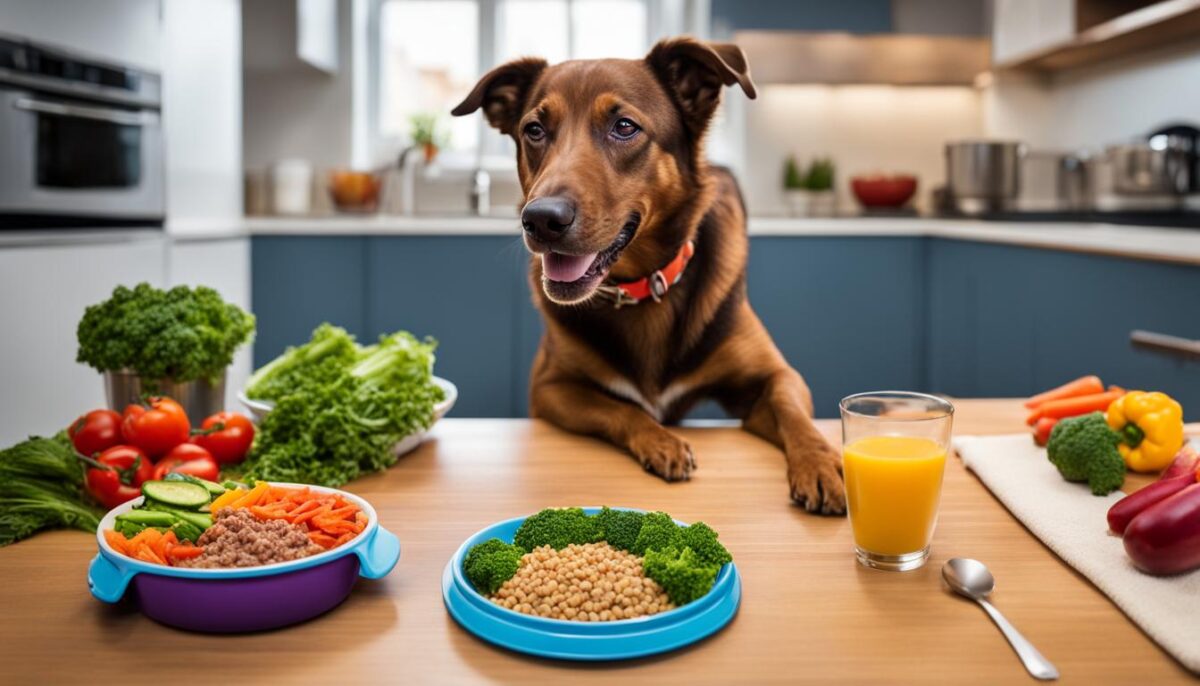If your pet has diabetes, you may wonder what they can eat to stay healthy. To keep your dog healthy, it’s important to feed them a proper diet. This helps control their blood sugar, maintain their weight, and keep them energized. In this article, we’ll go over what you need to know about feeding a diabetic dog for a healthy lifestyle.
To feed a diabetic dog, start by understanding canine diabetes and its impact on their diet. Diabetes in dogs is a disease that affects their insulin levels and can lead to high blood sugar levels. Insulin is a hormone that helps control blood sugar levels in the body. People with diabetes have trouble controlling their blood sugar levels. This is why a proper diet is crucial in managing your dog’s diabetes.
Keep reading to learn more about how you can feed your diabetic dog a healthy and balanced diet.
Understanding Canine Diabetes and Diet
If you have a diabetic dog, it’s important to understand the impact of their diet on their health. Dogs with diabetes, also called diabetes mellitus, have trouble making or using insulin. If a diabetic dog doesn’t manage their insulin well, their blood sugar levels can get too high. This can harm their body over time.
Dogs with diabetes are like humans with diabetes. Dogs also need insulin to control their blood sugar. The pancreas makes insulin, a hormone. Insulin helps glucose enter cells for energy. When there is no insulin, glucose builds up in the blood, causing high blood sugar levels. This can cause different health problems.
Canine diabetes is divided into two types: Type 1 and Type 2. Type 1 diabetes happens when the pancreas can’t make enough insulin. Type 2 diabetes happens when the body can’t use insulin. Both types need careful management. This includes watching what you eat, taking insulin shots, and checking your blood sugar often.
Insulin is important for managing diabetes in dogs. It’s crucial to maintain stable blood sugar levels. You can achieve this by getting insulin injections and eating a diet with lots of protein and few carbs.
In the following sections, we will discuss why a balanced diet is important for dogs with diabetes. We will also cover the right ingredients to use in their meals and provide helpful tips for feeding them. We will examine high-fiber foods and different types of diabetic dog food.
Importance of a Balanced Diabetic Diet
When it comes to managing diabetes in dogs, a balanced diet is crucial. A good diet can control blood sugar and help diabetic dogs manage their weight.
Carbohydrates are an important part of a balanced diabetic diet. But it’s crucial to choose the right types of carbohydrates. Opt for healthier options like brown rice and oats instead of sugar and white bread. Simple carbohydrates can cause spikes in blood sugar levels, which can be dangerous for diabetic dogs.
It’s also important to check your dog’s weight. Obesity can make it harder to control blood glucose levels and can lead to other health problems. Your veterinarian can help you determine the right weight for your dog and develop a plan to achieve and maintain that weight.
Besides carbs and weight, there are other things to consider when managing your dog’s diabetes. These include:
-
Choose protein sources that are low in fat and suitable for dogs with diabetes.
-
Adding fiber to your dog’s diet can help control blood sugar and improve digestion. Look for high-fiber foods or consider adding a fiber supplement to their meals.
-
Make sure your dog’s diet has all the vitamins and minerals they need for good health.
To keep your dog healthy and manage their diabetes, it’s important to feed them a balanced diet. Work with your veterinarian to develop a diet plan that meets your dog’s individual needs and helps them live their best life.
The Right Ingredients for Diabetic Dogs
When it comes to managing diabetes in dogs, a balanced diet is crucial for their health. To keep your pet healthy and control their blood sugar, choose the right ingredients for their meals.
Importance of Healthful Ingredients
To keep your dog healthy and full of energy, use nutritious ingredients in their diet. Choose lean protein sources like chicken, turkey, or fish that are easy to digest and low in fat. To regulate blood sugar levels, you can add low-glycemic carbs such as sweet potatoes and green beans.
Remember: Consult with your vet before making any significant changes to your dog’s diet.
Fiber Content
Fiber is another critical component of your diabetic dog’s diet. It aids digestion and slows glucose absorption in the blood. Foods like oat bran, barley, and psyllium help control blood sugar. Pea fiber and beet pulp aid digestion too.
Feed your dog a diet with around 3% to 5% crude fiber. Avoid high-fiber diets with over 10% crude fiber to prevent nutrient deficiencies.
Suitable Protein Sources
While a high-protein diet may seem like a good option for your dog, it can be harmful to their liver and kidneys. Instead, aim for a diet that has a moderate amount of protein, around 25% to 30% of their daily calorie intake. Choose lean protein sources, like chicken or fish, and avoid red meats and organ meats that are high in fat.
Image Example
At first, creating a balanced meal for your diabetic dog may be challenging. Make sure your dog gets all the right nutrients by talking to a vet or nutritionist.
Tips for Feeding Diabetic Dogs
It can be hard to feed a dog with diabetes, but following guidelines can help keep them healthy. Here are some tips to help you:
Part Control:
It’s crucial to check the amount of food your dog eats. Overfeeding can cause weight gain, which can lead to further health complications. Consult with your vet for guidance on the appropriate part sizes for your dog’s weight and breed.
Weight Loss Strategies:
If your dog is overweight, your vet may recommend a weight-loss program. This could include reducing their food intake or changing to a low-calorie diet. It’s essential to follow the vet’s advice to maintain a healthy weight for your dog.
Meal Consistency:
Stick to a regular feeding schedule and avoid skipping meals. Feed your dog at the same times every day and give them consistent part sizes. This will help control their blood sugar and manage their insulin needs. Feeding your dog at the same time every day helps establish a routine and keeps them healthy.
Feeding your diabetic dog requires discipline and attention. By eating well and staying active, you can help your pet live a healthy life.
Before changing your dog’s diet or trying to help them lose weight, talk to your vet.
High-Fiber Foods for Diabetic Dogs
If you have a diabetic dog, you know how important it is to manage their blood sugar levels. One way to do this is to make sure they get plenty of fiber in their diet. Fiber slows down the digestion of carbohydrates, preventing spikes in blood sugar levels.
There are two types of fiber: soluble and insoluble fiber. Soluble fiber mixes with water to make a gel in your dog’s stomach. Insoluble fiber doesn’t mix and helps make your dog’s poop bigger. Both types of fiber are essential for your dog’s health.
Some high-fiber foods that are suitable for diabetic dogs include the following:
-
Green beans
-
Pumpkin
-
Broccoli
-
Carrots
-
Sweet potatoes
You can feed these foods to your dog raw or cooked. Be sure to cut them into small pieces to prevent choking, and don’t add any salt or seasonings.
If your dog doesn’t like the taste of high-fiber foods, there are also fiber supplements available that you can mix into their meals. Just be sure to talk to your vet before adding any supplements to your dog’s diet.
Remember, fiber is important for your dog’s health, but too much can cause problems. It can cause diarrhea or constipation and make it harder to absorb important nutrients. Remember to ask your vet how much fiber is best for your diabetic dog.
Exercise and Diabetic Dog Health
Regular exercise is important for managing a diabetic dog’s condition. Exercise can help with weight management and blood sugar control, both of which are crucial for your dog’s health.
Exercising can help your dog lose weight or stay at a healthy weight. This can prevent problems caused by obesity. Exercise can help your dog’s body use insulin better, control blood sugar, and decrease insulin injections.
But how much exercise is enough for a diabetic dog? The answer depends on your dog’s age, weight, and health condition. Talk to your veterinarian for guidance on how much exercise is safe for your dog.
Here are some tips to keep in mind when exercising your diabetic dog:
-
Start slow and increase the intensity and duration of exercise. It’s important to avoid overexertion, especially if your dog is not used to regular exercise.
-
Be consistent with exercise by scheduling walks or playtime at the same time every day.
-
Check your dog’s blood glucose levels before and after exercise, especially if they are on insulin therapy.
-
Don’t exercise your dog right after a meal or insulin injection, as this can affect their blood sugar levels.
-
Choose low-impact exercises, such as walking or swimming, to avoid joint problems or other health issues.
Exercise is an essential part of managing diabetes in dogs. Regular exercise, combined with a healthy diet and proper insulin management, can help your diabetic dog live a happy and healthy life.
Commercial Diabetic Dog Food Options
If you have a diabetic dog, it’s important to consider their diet. There are lots of dog foods made for dogs with diabetes that you can buy. These special diets can help control your dog’s blood sugar and keep them healthy. Here are some things to keep in mind when considering commercial diabetic dog food:
-
Diabetic dog food: Look for dog food labeled for diabetic dogs. These formulas are designed to have the appropriate balance of nutrients and fiber to help manage blood sugar levels.
-
Prescription dog food: Your veterinarian may recommend a prescription dog food for your diabetic dog. These foods are made for diabetic dogs and usually need a prescription from your vet.
-
Dry food: Dry food is a popular option for many dog owners. Look for dry dog food formulas that are high in fiber and have a low glycemic index to help manage blood sugar levels.
-
Some diabetic dogs may be sensitive to grains. It’s important to choose grain-free dog food. Look for dog food that uses alternative sources of carbohydrates, such as sweet potatoes or peas.
If your dog has diabetes, talk to your vet about which dog food to choose. They can help you choose the best option for your dog’s specific needs and give you guidance on part sizes and feeding schedules.
Homemade Diabetic Dog Food
If you’re looking to take control of your diabetic dog’s diet, making homemade food can be a great option. Not only can it allow you to use fresh, high-quality ingredients, but it can also give you more control over the nutrients your dog is receiving. To create a healthy diet for diabetic dogs, you need to pay attention to details and understand nutrients.
Ingredients
When you cook for your diabetic dog, use ingredients with less carbs and more protein. Good protein sources include lean meats like chicken and turkey, as well as eggs and fish. Vegetables like green beans, carrots, and broccoli are also great choices, as they are low in sugar and high in fiber.
To prevent diabetes-related problems, avoid high-fat ingredients, especially for overweight dogs. Additionally, ingredients like white rice and potatoes should be avoided, as they can cause spikes in blood sugar levels.
Proper Diet
When making a diet for dogs with diabetes, make sure they get all the nutrients they need. This includes vitamins, minerals, and essential fatty acids. To make sure your dog gets all the nutrients it needs, add supplements to its homemade food. Talk to your vet to find the right supplements for your dog’s needs.
Supplementation
In some cases, diabetic dogs may also need insulin supplementation. If this is the case for your dog, it’s important to work with your veterinarian to determine the correct dosage and frequency. To make sure the insulin is working, check your dog’s blood sugar levels often.
Cooking your dog’s meals at home can be a good choice if they have diabetes. make sure their diet is balanced. Always consult with your vet to find the best plan for your dog’s needs.
A bowl filled with colorful vegetables and lean protein, surrounded by measuring cups and spoons. A smiling diabetic dog looks on .
Conclusion
As a pet parent of a diabetic dog, you play a crucial role in managing your furry friend’s health. You can help them live a happier and healthier life by giving them healthy food and managing their insulin levels.
To manage your dog’s diabetes, feed them a healthy diet with lots of nutrients and few carbs. By regulating their blood sugar levels, they can prevent sudden spikes and complications.
Work with your vet to create a plan that meets your dog’s needs. You can feed diabetic dogs either special dog food or homemade meals that match their dietary needs.
Remember, proper insulin management is critical to the health of your diabetic dog. Make sure to follow your vet’s instructions for medication and dosages. Contact them with any questions.
With a little extra care and attention, you can help your diabetic dog live a long, happy, and healthy life.
FAQ
What can diabetic dogs eat for a healthy lifestyle?
Diabetic dogs should follow a balanced diet that is low in carbohydrates and high in protein. It is important to consult with your veterinarian to determine the best diet plan for your specific dog.
What is canine diabetes, and how does it affect a dog’s diet?
Canine diabetes is a condition where a dog’s body cannot regulate blood sugar levels. This impacts their diet as they need a diet that helps control blood sugar levels and maintain health.
Why is a balanced diabetic diet important for dogs?
Dogs need a balanced diet. It helps regulate blood sugar, maintain weight, and keep them healthy.
What are the right ingredients for diabetic dogs?
Dogs with diabetes need a diet that has good protein, low-glycemic carbs, and moderate fat. It is important to choose ingredients that support their health and maintain stable blood sugar levels.
Any tips for feeding diabetic dogs?
When you feed a dog with diabetes, it’s important to have a regular schedule. Also, check the part sizes to keep a healthy weight. Work with your vet to create a meal plan that suits their needs.
What are high-fiber foods and their benefits for diabetic dogs?
Foods with a lot of fiber can help diabetic dogs in several ways. They can regulate blood sugar levels, improve digestion, and make the dog feel full. Adding fiber to their diet can be beneficial in managing their condition.
How does exercise impact the health of diabetic dogs?
Diabetic dogs need regular exercise to manage weight and control blood sugar levels. To keep your dog healthy, choose exercises that are suitable for their health and breed.
Are there commercial options for diabetic dog food?
Yes, you can buy special food for dogs with diabetes. There are different kinds to choose from. These options are formulated to meet the nutritional needs of diabetic dogs.
Can I prepare homemade diabetic dog food?
To make diabetic dog food at home, consult a vet or nutritionist for a proper diet plan. Homemade food requires careful consideration of ingredients and necessary supplementation.
What is the conclusion about diabetic dogs and their diet?
In conclusion, a healthy diet plays a vital role in managing diabetes in dogs. To keep diabetic dogs healthy, they need proper insulin management, a balanced diet, and regular vet care.


